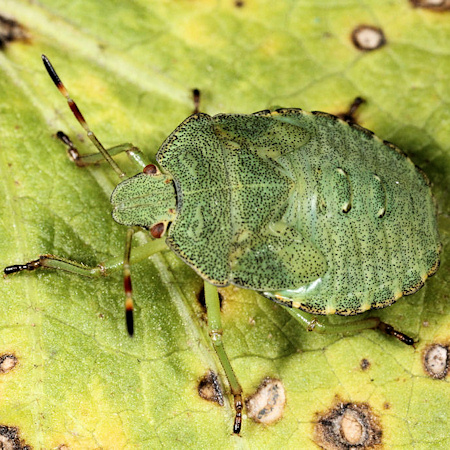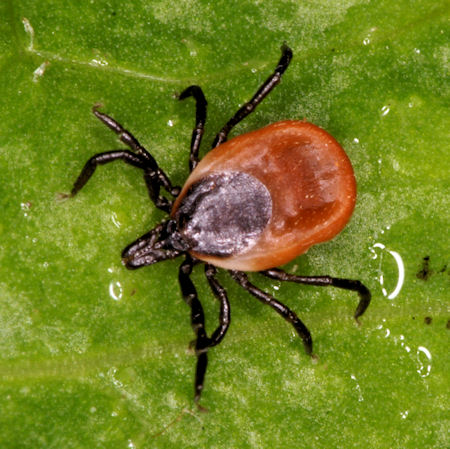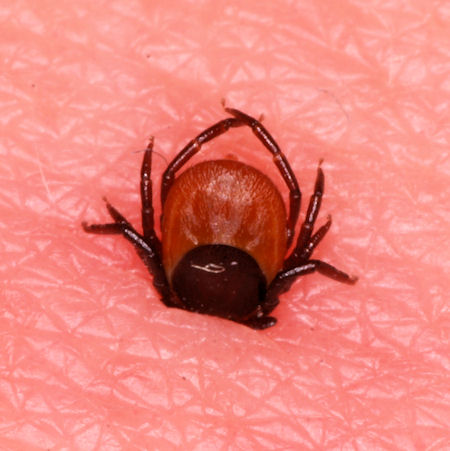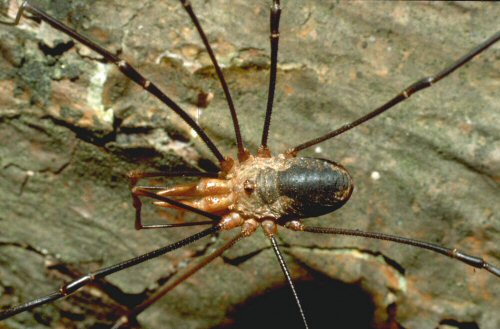The spider
|
Introduction |
|
These pages are also available in one pdf file: The spider.pdf.
Introduction
|
|
|
| Palomena prasina, green bug, an insect |
Dolomedes, fishing spider, a spider |
Many people confuse spiders with insects. The easy way to recognize the spider from an insect is that spider has 4 pairs of legs and an insect has 3 pairs. |
|
|
|
Unlike insects, spiders do not have antennas. |
|
There are also many similarities. Both have an external skeleton (exoskeleton). The hard part of the body is on the outside while mammals have their skeleton (bones) inside the body. The heart is located on their back. Breathing is performed with trachea and / or book lungs. The oxygen transport protein is hemocyanin and not the mammalian transport protein hemoglobin. In 1758-59 Carolus Linnaeus published the 10th edition of
Systema Naturae in which he classified animals. Over the years
the biologists improved the systematic study of the Animal Kingdom.
According to this study we have single cell animals at the bottom and at
the top are humans with very complex cell systems. With the aid of Phylum Arthropoda is divided into 5 major classes. |
|
| Class |
Crustacea |
Arachnida |
Diplopoda |
Chilopoda |
Insecta |
| Examples |
Lobsters, crabs |
Spiders |
Millipedes |
Centipedes |
Flies, maggots |
| Body parts |
Cephalothorax and abdomen |
Cephalothorax and abdomen |
Head and body |
Head and body |
Head, thorax and abdomen |
| Pair of legs |
Many, usually 5 pairs |
4 pairs |
Many, 2 pairs per segment |
Many, 1 pair per segment |
3 pairs, 1 on each thoracic segment |
| Antennae |
2 pairs |
None |
1 pair |
1 pair |
1 pair |
| Described number of species |
25,000 |
40.000 |
5000? |
5000? |
800.000 |
Class Arachnida is divided into 11 orders.
|
1. Araneae |
2. Scorpionida |
3. Pseudoscorpiones |
4. Solfiguae |
5. Schizomida |
|
|
Spiders |
Scorpions |
Pseudo-scorpions |
Solifugids |
Tartarida |
|
|
6. Amblypygi |
7. Palpigradi |
8. Ricinulei |
9. Acari |
10. Opiliones |
11. Thelyphonidae |
|
Tailless whipscorpions |
Mini whip scorpions |
Rinucleids |
Mites en ticks |
Harvestmen |
Whiptailes scorpions |
Accordingly the spider is placed in phylum Arthropoda, class (classis)
Arachnida, order (ordo) Araneae. This order is
further divided into 3 sub-orders.
The Mygalomorphae (the primitive spiders), the Aranaeomorphae (the modern
spiders) and the Mesothelae, with one family of spiders the Liphistiidae.
Every spider belongs to a family, which is further divided into genus,
followed by species.
The European garden spider belongs to the family Araneidae, the genus
Araneus en the species diadematus. As a rule genus and species are
printed in italics.
In our world in September 2008 40462 species in 3964 genera spiders are
described.
In June 2008 the folowing 58 families with 5400 species of European spiders
were described:
| Family | count | Family | count | Family | count | |||
1 |
Agelenidae | 154 |
21 |
Idiopidae | 2 |
41 |
Salticidae | 459 |
2 |
Amaurobiidae | 95 |
22 |
Leptonetidae | 65 |
42 |
Scytodidae | 14 |
3 |
Anapidae | 6 |
23 |
Linyphiidae | 1550 |
43 |
Segestriidae | 19 |
4 |
Anyphaenidae | 8 |
24 |
Liocranidae | 63 |
44 |
Selenopidae | 2 |
5 |
Araneidae | 179 |
25 |
Lycosidae | 330 |
45 |
Sicariidae | 5 |
6 |
Atypidae | 4 |
26 |
Mimetidae | 11 |
46 |
Sparassidae | 27 |
7 |
Cithaeronidae | 2 |
27 |
Miturgidae | 34 |
47 |
Telemidae | 2 |
8 |
Clubionidae | 73 |
28 |
Mysmenidae | 16 |
48 |
Tetragnathidae | 48 |
9 |
Corinnidae | 34 |
29 |
Nemesiidae | 55 |
49 |
Theraphosidae | 9 |
10 |
Ctenizidae | 11 |
30 |
Nesticidae | 49 |
50 |
Theridiidae | 295 |
11 |
Cybaeidae | 15 |
31 |
Oecobiidae | 49 |
51 |
Theridiosomatidae | 2 |
12 |
Cyrtaucheniidae | 4 |
32 |
Oonopidae | 44 |
52 |
Thomisidae | 210 |
13 |
Dictynidae | 96 |
33 |
Oxyopidae | 14 |
53 |
Titanoecidae | 19 |
14 |
Dysderidae | 348 |
34 |
Palpimanidae | 7 |
54 |
Trochanteriidae | 2 |
15 |
Eresidae | 21 |
35 |
Philodromidae | 106 |
55 |
Uloboridae | 14 |
16 |
Filistatidae | 15 |
36 |
Pholcidae | 97 |
56 |
Zodariidae | 92 |
17 |
Gnaphosidae | 514 |
37 |
Phyxelididae | 2 |
57 |
Zoridae | 13 |
18 |
Hahniidae | 42 |
38 |
Pimoidae | 3 |
58 |
Zoropsidae | 9 |
19 |
Hersilidae | 5 |
39 |
Pisauridae | 17 |
|||
20 |
Hexathelidae | 4 |
40 |
Prodidomidae | 15 |
number of species |
5400 | |
One can find spiders in much
larger numbers than expected. The naturalist W.S. Spiders mostly prey on insects. Most insects are useful, although
some may be annoying. Therefore, it is difficult to say if a spider is
valuable or not. However, spiders do control the insect population to
some extent which makes them helpful, at least, in maintaining the right
balance in our eco system. |
|
| We will have a close look at the
near relatives of the spiders in |
|
|
|
|
| A closer look reveals two tiny black eyes, although, some varieties of scorpions have more than one pair of eyes. The sting with poison is mainly used for protection and for killing large prey. The scorpion sting is unpleasant for humans and can result in possible death. | A rather unknown scorpion order is the pseudoscorpion (order Pseudoscorpiones). This small creature is a few millimeter long and lives between detritus like leaves, bark, moss, mole- and bird nests. They have relatively long scissors that can be as long as the rest of the body for the males. They do not have tails or stingers. |
| Scorpion | Pseudoscorpion |
Even smaller than the pseudoscorpion are the ticks and the mites. Mites are found in a great variety of forms in all kinds of habitats
like deserts, in water, between rocks, in flour and in carpets, et
cetera. A species of mites, commonly known as house dust mites, can be
found in our houses and in our beds in huge numbers where they feed on
human dander.
Ticks are notorious because the Ixodid family of the ticks may cause
Lyme disease. Ticks cut a hole into the skin of a mammal and suck its
blood. Because their head is complete emerged into the skin they are
difficult to remove. |
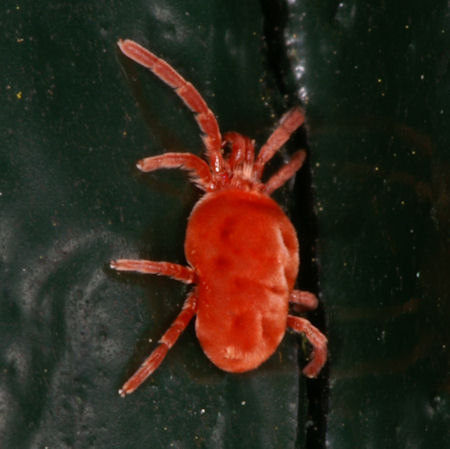 |
|
|
Velvet mite, Trombidium holosericeum
|
| Tick, Ixodes ricinus |
Above a tick in the authors skin and below after unsuccesfull removal |
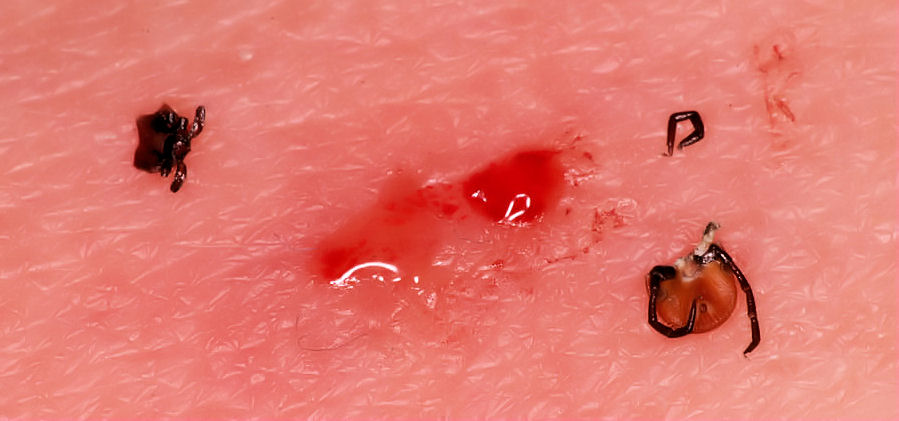 |
|
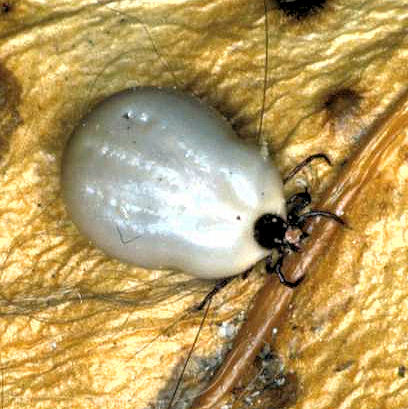 |
|
| Young tick. A few mm large and frantically running around | Tick, full with blood, sucked from its victim |
Harvestmen (order Opiliones) are often mistaken for spiders. Unlike
spiders, the two parts of the body (cephalothorax and abdomen) of a
harvestman are fused together into one part. They also have eight legs,
feelers and mouth parts that work like a pair of scissors. |
|
|
|
|
| Harvestman, Mitopus morio |
Harvestman, Phalangium opilio |
Next: The body
Ed Nieuwenhuys, 23 march 2023
December 2011, August 30, 2008, March 23 2008, 15 November 2006 , January 2006.10 January 1999
